Answered step by step
Verified Expert Solution
Question
1 Approved Answer
Needs to use the Gauss Seidel method in 3D to solve the given equation. Would prefer it written in python, but can translate if need

Needs to use the Gauss Seidel method in 3D to solve the given equation. Would prefer it written in python, but can translate if need be.
Step by Step Solution
There are 3 Steps involved in it
Step: 1

Get Instant Access to Expert-Tailored Solutions
See step-by-step solutions with expert insights and AI powered tools for academic success
Step: 2

Step: 3

Ace Your Homework with AI
Get the answers you need in no time with our AI-driven, step-by-step assistance
Get Started


